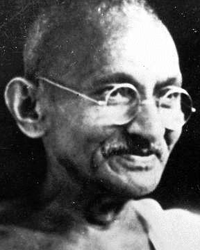
- Nonviolence: Twenty-Five Lessons from the History of a Dangerous Idea
- Modern Library (2006)
These days, when my thoughts turn to the increasingly desperate need for steadfast and principled non-violent resistance in the face of war and brutality around the world, I think of an especially brave man, a 46-year-old school teacher in the Afghan city of Ghazni.
His name was Mohammed Halim. He persisted in teaching young girls, despite repeated threats from the Taliban. Late last year, in the middle of the night, Halim was dragged from his crying children and his pleading wife. His body was later found in bits and pieces, in a heap, as a warning to other teachers.
I also think of the struggle being waged by the Pakhtunkhwa Milli Awami Party, a socialist and anti-war party the Pashtun people are increasingly turning to, in open defiance of the Taliban, right in the Taliban's Pashtun heartlands traversing the Afghan-Pakistan border.
The case of Mohammed Halim and of the heroic struggle of the Pakhtunkhwa serve as grim reminders that non-violent resistance to oppression is always right, proper and necessary, but sometimes it must also be accompanied by force of arms. Against certain kinds of enemies, non-violence just isn't enough.
However unpleasant this might be, it's the way the world is, and to pretend that it isn't is to harbour something the great British essayist and novelist George Orwell, writing in the Partisan Review in 1942, succinctly described as "a bourgeois illusion bred of money and security."
'Dangerous' all right
It's rare that a single text comes along that presents the persistence of that illusion in all its contemporary folly -- the "state" is bad, the "west" is always wrong -- but sadly, that's what's on offer in Mark Kurlansky's Nonviolence: Twenty-Five Lessons from the History of a Dangerous Idea (Modern Library, 2006).
I'm no stranger to the moral power of non-violent resistance. I was named after Terence McSwiney, the Irish revolutionary who died on the 75th day of his hunger strike in Brixton prison, in 1920. Not long after I graduated from high school, I was getting myself arrested at protests at the Trident nuclear submarine base in Bangor.
As a trade unionist, I led an occupation of the first daily newspaper I worked for, the first labour shutdown of the paper in its 120-year history. As a journalist, I've been privileged to witness, first-hand, countless successes in strikes, civil disobedience campaigns, boycotts, logging-road blockades and so on.
I'm for it.
But there is a point where non-violence, at least on its own, won't work. Even the classic case of the famously non-violent American civil rights movement is evidence of that. The racial integration of schools and other public services was always backed up by the threat of armed federal intervention.
Non-violent world?
There is also a point where one recoils from wishful thinking, fact-ignoring and history-twisting. Kurlansky's book will bring any intelligent and reasonably-informed reader to that point, and well beyond it.
Rather than provide a glimpse of what a better, kinder, non-violent planet might look like, Kurlansky quite inadvertently presents a vision of something else altogether. It's a dystopian future in which ordinary people are allowed no defence against tyranny except underground railroads that lead nowhere and "peaceful" protests where wave after wave of demonstrators present themselves to be mowed down by machine guns.
By Kurlansky's standards, you could be forgiven for thinking there's no realistic hope for a non-violent world: "To establish a world living in peace would require the abandonment of power politics both on the grand scale -- states trying to bend other states to their will -- and on the small scale -- legal systems coercing social behaviour with the threat of prison."
No peace without the state, in other words.
One would have expected so much better from the author of such fine works of narrative journalism as Cod: A Biography of the Fish that Changed the World and Salt: A World History. It doesn't help that the foreword was written by the Dalai Lama. There were times that I couldn't stop myself from thinking that when Kurlansky wrote this book he must have been high.
Among the 25 "lessons" from the book's title are the most puerile non-findings: "People who go to war start to resemble their enemy." "The longer a war lasts, the less popular it becomes." "Violence is a virus that infects and takes over." That kind of thing.
Missing is perhaps the most important and currently relevant truth about non-violence: "Against enemies immune to moral persuasion, it just doesn't work."
Kurlansky does have some eminently defensible and interesting arguments to make. The Americans needn't have waged a bloody war to win independence. The War of 1812 was unnecessary and stupid. The American Civil War wasn't about freeing the slaves. The First World War was a frivolous war between Europe's ruling classes, with the workers used as cannon fodder.
But these arguments have already been made, and they have been made elsewhere, in much better books.
Cartooning complexity
Mostly, this book is a rehashing of hippie pieties. Early Christianity was "an antiwar cult" (but somehow everything went sour after the Roman empire stopped feeding Christians to the lions). The American pledge of allegiance is merely a ploy to condition young boys for war. Non-violent activists are always considered "a threat, a direct menace," to the state. And the "violent people who have been governing societies" always "co-opt" religion for their war-making purposes.
In every historical period he considers, Kurlansky manages to reduce complexity to a cartoon. Sinister state forces are always at work, always successful in setting off wars. After all, "it is always easier to promote war than peace."
This was certainly not the case that prevailed among the European powers during the 1930s when Spanish rightists, aided by Nazi Germany and Mussolini's Italian fascists, moved to seize power in Madrid.
The job of holding the line against fascism fell to indigenous leftist militias and legions of civilian volunteers that poured into the country from abroad. They failed, and fascism consolidated its first gains in Europe. The result was protracted warfare on a scale Europe had never known.
Kurlansky skirts all this and goes thrashing through the brambles of some of the most peculiar historical revisionism this side of the Holocaust-denial fringe. He begins by making a wholly unnecessary case that the Second World War was not fought to save the Jews (what serious historian makes that claim?), and then blames Hitler's enemies, no less, for the Holocaust.
Handling Hitler
Turns out we should never have declared war on Germany in the first place, because that's when the extermination camps began their grim business. Don't ask me how Kurlansky might square this with his own admission that it was Hitler's intention to slaughter the Jews all along. He doesn't even try.
True, "non-violent resistance" is a term one can use to describe all those ordinary people who hid Jews and successfully saved Jews during the years of the Nazi terror. But it is outrageous to diminish the legacy of that resistance, as Kurlansky does, by tarting it up as the only proper way to have confronted Nazism.
Kurlansky dives into this anyway, favourably citing Denmark's capitulation to Germany on the grounds that the Danes managed to hide some Jews and sneak them out of the country under the noses of their Nazi occupiers. From this, Kurlansky argues that if the salvation of the Jews was what mattered, "the best chance would have been not going to war."
He goes further. The Holocaust was at least partly the fault of the Jews themselves for having failed to produce "an effective means of resistance." Instead: "They met their fate either passively or with violent resistance, either of which responses resulted fairly quickly in their deaths."
Hiding Jews from Hitler, but not fighting back -- this could have gone on for how long, exactly? Sitting around cross-legged and singing folks songs and going limp when you get arrested -- this would have changed Hitler's mind? I don't think so.
And I don't expect it will work against the Taliban, either, I'm afraid.
They will cut you into little pieces, like they did to Mohammed Halim. ![]()




